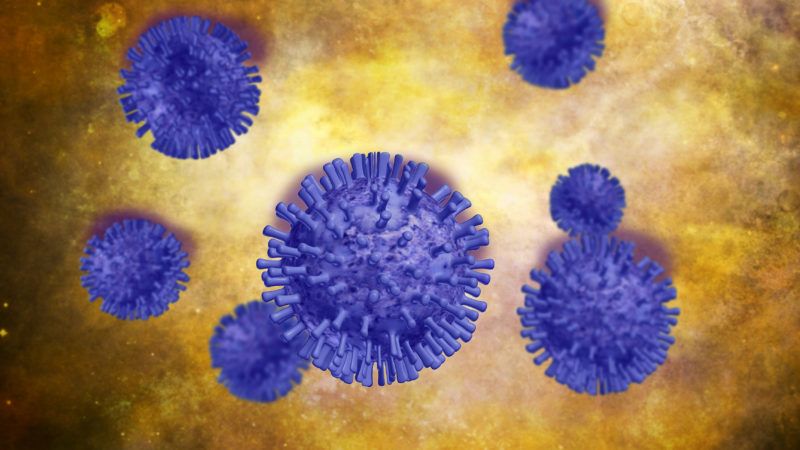COVID-19 Deaths Are Now Rising in the U.S., but Case Fatality Rate Continues To Fall
We are starting to see the fatal consequences of the recent infection surge.

Daily COVID-19 deaths in the United States, which have fallen dramatically since the spring and continued to drop even as newly identified cases surged, are now rising. According to the Worldometer tally, which is based on reports from local health departments, COVID-19 deaths averaged 948 during the last three days, compared to 302 during the previous three days. That's a pretty alarming increase in a short time, and it will have a significant impact on the total death toll if it proves to be more than a temporary spike.
The seven-day average of daily deaths, which is a better indicator of trends, has increased less dramatically. According to data scientist Youyang Gu's calculations, which are based on death tallies from the Johns Hopkins Coronavirus Resource Center, that number fell from 1,122 on May 25 to a low of 510 on July 4 and has since risen to 641, which is still more than 70 percent lower than the peak average of 2,238 on April 18. The New York Times database also indicates an increase in daily deaths this week, although the paper says "health experts cautioned that it was too early to predict a continuing trend from only a few days of data."
Gu, who has a good track record of predicting COVID-19 fatalities, is now projecting that daily deaths will rise to 774 in late August, then gradually fall to fewer than 500 by the end of October. He has increased his estimate of total deaths by October 1 from about 186,000—his projection at the beginning of this week—to about 192,000, rising above 200,000 by mid-October.
Because newly identified infections have more than tripled since Memorial Day, from fewer than 20,000 to more than 60,000 yesterday and the day before, daily deaths were bound to rise eventually. (According to the Centers for Disease Control and Prevention, the lag between laboratory confirmation and death is about two weeks.) Yet the nationwide crude case fatality rate—deaths as a share of confirmed cases—continues to fall. It is now 4.3 percent, down from more than 6 percent in mid-May. That trend likely reflects not only broader testing but also a younger mix of patients and improved treatment.
If the patient mix remains about the same, the case fatality rate could keep dropping even as daily deaths rise. But if the young and healthy people who seem to be driving the recent jump in cases pass the virus on to a lot of people who are more vulnerable to COVID-19, the case fatality rate could go up, as it did from late March to mid-May, when the patient mix was older and less healthy. Much will depend on precautions aimed at protecting people in high-risk groups.
The upward national trend in COVID-19 infections is largely due to dramatic increases in several Sunbelt states. On Wednesday, for example, California, Florida, and Texas, where a little more than a quarter of Americans live, accounted for more than two-fifths of newly confirmed cases.
"The current surge in coronavirus cases in the United States is being driven by states that were among the first to reopen their economies, decisions that epidemiologists warned could lead to a wave of infections," the Times says. But California's prominence in the recent wave of infections complicates that narrative.
California, which led the nation in imposing a lockdown and has been lifting it only gradually, nevertheless saw newly identified cases rise more than fivefold between Memorial Day and July 7, from 2,175 to 11,694. It recorded about 7,000 cases on Wednesday. "The state was once seen as a model for how to contain the virus," the Times says, "but experts blame the current surge on an inconsistent adoption of prevention strategies and a haphazard reopening process that gave people a false sense that they were in the clear."
Still, California does seem to be doing better in some respects than Texas and Florida, which have seen even bigger increases in newly identified cases and daily deaths since Memorial Day. The seven-day average of COVID-19 deaths in California rose from 70 on May 25 to 85 yesterday. During the same period, the average rose from 26 to 66 in Texas and from 36 to 56 in Florida.
Then again, Texas and Florida have lower case fatality rates: 1.3 percent and 1.7 percent, respectively, compared to 2.3 percent in California. That suggests patients are doing somewhat worse in California, especially since it has tested a larger share of its population than Texas or Florida has, which would tend to reduce the apparent fatality rate. And according to Gu's estimates, the COVID-19 reproductive number—the number of people infected by the average carrier—is slightly higher in California than in Texas or Florida.
What about states that never imposed stay-at-home orders? Since Memorial Day, daily new cases are up dramatically in Arkansas, Iowa, North Dakota, South Dakota, and Wyoming, but not in Nebraska. It sure looks like politicians' decrees play a smaller role in this pandemic than The New York Times thinks.


Show Comments (217)